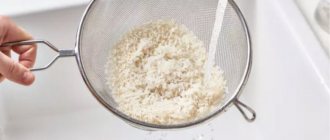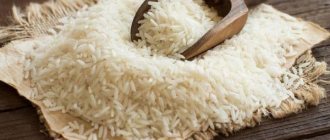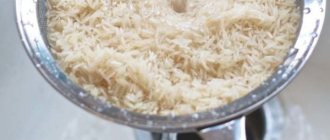Reviews (2)
8
Updated: Dasha Petrova
04/24/2017 Cooking time: 1 hour 10 minutes
| Save | I cooked) | Estimate |
I'll tell you how to cook pilaf from steamed rice with pork. Of course, you have probably cooked pilaf more than once; each housewife has her own personal recipe. And I’m happy to share mine. You'll like it!
Steamed or polished
Experienced chefs know what makes pilaf successful. It's about choosing the right rice. Considering the variety of this cereal on store shelves, it is worth learning to understand its varieties, types and quality.
Steamed and polished have already undergone certain processing to improve taste. But are both suitable for preparing oriental dishes? Steamed or heat-treated rice is the best for many cooks; it has a crumbly structure and absorbs moisture well. The prepared food comes in large quantities and is rich in vitamins.
Polished grains are rarely purchased for pilaf, since after deep processing they acquire a smooth shape, translucent, white color, vitamins and microelements are practically absent. It is better to use this product for preparing viscous porridges.
Common Questions
If you cook pilaf for the first time, you will probably have a lot of questions along the way. It is worth knowing that cooking pilaf is actually a simple and not labor-intensive process, of course, if you are not going to make 7 tons at a time.
Any housewife who knows how to properly cook rice and meat separately can easily cope with pilaf, because for this, parts of a single whole need only be assembled into one very tasty and unique dish. Naturally, based on certain rules. Nowadays, many chefs and cooks prepare pilaf and do not hide their own secrets and recipes. Housewives exchange clear and detailed videos that can help even a beginner prepare pilaf.
What to do with over-salted pilaf
Unfortunately, it is very easy to overdo it with salt, and even great chefs can do it. It is worth knowing, first of all, that zirvak is intentionally slightly over-salted, since when evaporating, the rice receives some of this salt. Boiled rice itself is very easy to desalinate - just rinse it in hot water once or twice. But what to do when trouble happens with such a complex and complex dish as pilaf?
If you have oversalted the meat, then at this stage the situation is very easy to correct - you can add a little water or put peeled raw potatoes in the broth for a few minutes - they absorb excess salt perfectly. Dry grains of rice work in the same way: they are usually wrapped in cheesecloth and dipped into the first and second courses to even out the taste of the food.
It is very important at the stage of preparing zirvak to taste the pilaf for salt, as this will help avoid further disappointment. Remember that it is always better not to add it than, on the contrary, to add too much.
Unfortunately, it is impossible to fix already prepared pilaf, since it is not just food, but a composite dish. But don’t despair - you can use it in the future as a filling for stuffed peppers, a seasoning for soup, or offer it to a person who loves salty foods.
How to cut carrots for pilaf
There are no specific and generally accepted standards - Uzbeks prefer to chop carrots into strips, and then mix them carefully so as not to break them when they boil, so that the dish turns out like in the picture, but you can subjugate vegetables into any shape: cubes, cut with a curly knife, even grate.
Many Uzbeks believe that carrots are the soul of pilaf, as they are able to give a certain sweetness to a dish, so they are very strict in choosing and cutting them, but if you are not going to treat an Uzbek dish to a native resident, then you don’t have to worry about such little things and even cross out carrots from the ingredients.
Why did pilaf turn out to be porridge?
The most common mistake of all people who make pilaf for the first time. Rice is a fastidious grain that cooks very easily, this can be seen even in ordinary porridge. It quickly absorbs water and swells, so you need to control the process and then dry the finished mass in time.
The pilaf itself can become porridge if you add too much water (not 1 to 2, but more), or cover the pan with a lid during the process of evaporating it. The liquid from the bottom rises to the rice and steams it, coming out, so any interference in this small “ecosystem” has a bad effect on the final result.
How to cut carrots into strips
According to the standard, it is customary to chop carrots into thin strips of approximately 3-4 centimeters. This is more of a relic of the past and a habit rather than a necessity, so you can change the length or width of the vegetable blocks as desired. To make it easier to cut carrots, first divide them into thin slices and then chop them vertically, adjusting the length as desired.
Do I need to stir pilaf after cooking?
In some families, the entire cauldron (if it is small) is simply turned over so that the meat is on top and logically completes the entire composition, but you can do as you see fit.
If guests don’t know that this is pilaf and not just boiled rice, they may not get to the meat, so it’s better to negotiate on the shore or immediately distribute the components so that they can be seen.
Is it necessary to stir pilaf during cooking?
Almost all recipes say that pilaf must be laid out in layers, and stirred only at the very end, when the rice is cooked. This is connected not so much with the cultural past of Uzbek food, but with oriental cooking technology.
During cooking, the zirvak broth and hot water evaporate as they pass through the rice. The cereal absorbs the required amount of liquid, and as a result we get the perfect crumbly pilaf with a pleasant consistency.
If you stir all the ingredients during the process, the rice may not cook evenly, especially when you use a saucepan. Pilaf is cooked in cauldrons because it has a small area of contact with the fire, but once underneath, the rice can easily burn. Therefore, you will have to periodically check the food and control the size of the fire.
Do I need to cover the pilaf with a lid?
Every family has a different opinion about this. According to experts, pilaf should never be covered, since the whole point is to steam the rice with liquid. It is allowed to cover with a lid only after boiling water has been added - then you need to turn on very high heat and let the whole mass boil faster. Then the lid is finally removed.
Some people advise covering the pilaf with foil with holes made in it so that the rice is steamed, but not boiled. But this is not necessary, because if you added the right amount of water and followed the recipe, the rice will cook perfectly without foil.
How much salt to put in pilaf
In this matter, everything depends on the amount of ingredients. For 1 kg of meat and 1 kg of rice, 1.5 tablespoons of salt is enough. It and the spices are poured in at the stage of preparing zirvak, so you can add it a little and taste it. The broth should be slightly salted to give some of it to the rice. It is not necessary to adhere to strict proportions, since every family has its own taste preferences.
What is added to pilaf
Each country has different recipes: in some regions of Azerbaijan it is customary to prepare pilaf exclusively from meat, rice and salt, so that no extraneous smells or tastes distract from the true national food.
In Uzbekistan, zirvak is prepared from fried onions, carrots, fat tail fat and lamb. Only cumin and salt are added to this pilaf. In stores you can find special bags with spices “For pilaf”, curry and suneli hops, which also contain cumin, dried barberry, turmeric (gives a characteristic yellowness), saffron and coriander, but whether you sprinkle such seasoning or not is your personal choice.
In addition to spices, red pepper and garlic are added to pilaf - as you know, spicy foods perfectly stimulate the appetite, so Uzbeks usually overeat with pilaf. For color, some countries also add tomatoes or tomatoes to give the rice a deep orange hue. It is advisable to prepare spices in advance and place them on the table so that you don’t forget anything later.
How many times does the rice in pilaf increase?
Rice in hot water can expand almost 6 times in volume relative to its initial state, so liquid should be added in strict proportions if you did not initially intend to get boiled porridge. When preparing pilaf, water is usually added twice as much as rice, then the cereal turns out crumbly and tasty.
How much oil is needed per kg of pilaf
Very often people complain that pilaf burns, no matter how much oil they add, but the problem is not that, but that cooks neglect recipes, mix ingredients or turn on high heat.
Pilaf will never burn if only zirvak is in the oil. Uzbeks use exclusively fat tail lard, approximately 300 grams, as a fat base, but it can be easily replaced with 300 ml of sunflower oil so that meat and vegetables can be fried on all sides without any problems.
There is another common cooking option - with cottonseed oil. It is not necessary to use it, but it was added only because it is much cheaper than sunflower and olive oil.
The pilaf was not cooked through, and all the water boiled away
Finishing rice is much easier than saving boiled porridge. If the cereal is still crunchy in your teeth, but there is no water, try adding a little boiling water, about 50 ml, so as not to overdo it. You still cannot stir, otherwise the rice will not steam. To help the water evaporate, you need to make several holes with a wooden stick to the very bottom and wait until the water boils away again.
Why did the pilaf turn out dry?
The leading role always belongs to the zirvak - even at the stage of stewing the meat, you must make sure that it releases enough of its own juice.
You should be especially careful with chicken and beef, as the meat can easily be stewed to a “rubbery” state. The same thing can happen with old lamb, so be sure to consider the cooking time for each type of meat. Rice can turn out dry for only one reason - if you added too little water. This can be corrected by adding another 50 ml of liquid.
Why did pilaf turn out to be porridge?
Rice in inept hands turns into a very capricious cereal, as it is easy to overcook. This can happen in several cases. If you constantly stirred the pilaf while cooking, and it cooked unevenly. Moreover, the fat contained in the broth easily sticks together the grains of rice, so it is customary to lay out the ingredients in layers.
Rice can also stick together or remain runny if you added too much water or covered the pot with a lid so that the excess moisture was unable to boil away and was not allowed to evaporate.
Which rice to choose for pilaf
This question is asked by many inexperienced housewives. Sometimes you can find the inscription “for pilaf” on the packs, but often this is just a marketing ploy. The price/quality ratio is not always justified. Quite expensive varieties are often counterfeited by coloring ordinary rice. This is easy to check: if the water turns colored during soaking, it means you purchased a fake. Also, the Chinese have long learned to mix synthetic resins with starch, from which they form grains.
The main requirements for cereals for pilaf are: hardness, ribbed structure, grain integrity - a high-quality cereal will not break, burn in dishes, have a clearly different yellowed or white appearance, stick together, and must absorb water, aromas of seasonings and fats well.
To prepare oriental food, today it is better not to use crushed, finely polished cereals, because they contain a lot of starch. When cooked, the grains stick together and swell. But Soviet housewives could not afford to often buy high-quality imported cereals and resorted to a little trick - first they fried ordinary cheap rice in oil. With this method, the starch is “sealed” in it, and the grains do not lose their shape.
Devzira is the best long-grain variety, but also the most expensive, which can expand seven times during heat treatment, perfectly absorbs aromas, and always turns out crumbly. It was created specifically for pilaf, bred by breeders. The cereal has a pleasant beige color, a sweetish taste, and contains almost no starch. Preparing a real tasty oriental side dish from devzira is not difficult. A characteristic feature is its weightiness.
Spices
How much water you need per glass of rice for pilaf is undoubtedly important to know. But there are other secrets. So, every oriental cook knows that the basis of the dish is spices. Ideal for pilaf:
- cumin (cumin);
- hot pepper pods;
- garlic;
- black pepper.
It is better to take sea salt, as it fully reveals the taste of each of the ingredients. If you follow all the cooking rules, the dish should turn out simply unsurpassed. It is prepared with the addition of different types of meat. It can be lamb, pork, beef, chicken and even seafood.
Brown
Brown or brown cereal has many advantages: unusual taste, low calorie content, and a minimum of starch contained in it. It consists of unpolished cereals that are minimally processed and retain a greater amount of beneficial microelements. The grains have a slightly nutty aroma that lingers during cooking due to the bran shell. They contain amino acids, proteins, essential dietary fiber, B vitamins, and minerals. When consuming the product, the body receives slow carbohydrates, which take a long time to be consumed, and hunger occurs much later than usual.
The disadvantages are the high cost and short shelf life.
The most popular brown rice is indica. This variety undergoes very careful processing and preserves the embryos that are beneficial to the human body. When sprouted, high-quality grains always sprout.
White
White polished rice is familiar to everyone since childhood. It is the cheapest, but stores well. You can quickly cook porridge from it (in about 15 minutes). But in terms of health benefits, it is significantly inferior to brown rice - white rice does not have a bran shell. The shapes are divided into long-grain (practically does not stick together), medium-grain (becomes soft), round (quickly sticks together). But there are varieties of white cereals that are well suited for pilaf. Among the best white grains for pilaf are Basmati (long-grain, with proper preparation the volume doubles, the product turns out crumbly), Arborio (medium-grain, round-grain, remarkably absorbs the odors of spices and meat), Krasnodar (round, slightly elongated), Jasmine (does not boil and does not stick together).
Krasnodar
The most fluffy rice is long grain rice. Despite the fact that Krasnodar rice is a soft variety, there are cereals containing large amounts of amylose. Thanks to it, the rice keeps its shape perfectly during cooking. These varieties include Flagman, Regul, Khazar, Rapan. They contain up to 25% amylose.
In order for the side dish of Krasnodar rice to turn out “as it should,” certain culinary rules must be followed. First you need to rinse the rice until the water is clear, dry it in a colander and pour it into a saucepan with a thick bottom. Add a tablespoon of oil and, stirring, keep on fire for 1-2 minutes. Pour 3 cups of boiling water over the product and cook for 20 minutes over low heat, adding salt 5 minutes before it’s ready. Boil, drain again and rinse. After this, add oil to the side dish. The result is an elastic, slightly sweet and soft product.
What you need for cooking
If we consider the version of Uzbek pilaf, which is traditionally prepared from long-grain rice, then it will require the following products:
- vegetable oil – 100–150 ml (the classic recipe uses cottonseed oil);
- steamed rice – 500 g;
- lamb – 500 g;
- carrots – 3 pcs.;
- onions – 2–3 pcs.;
- garlic – 1 whole head;
- spices: hot pepper and cumin;
- salt;
- bay leaf (optional).
In fact, there is no standard pilaf recipe that you need to follow. Different countries prepare this dish in their own way. For example, we often cook it with pork, whereas in oriental cuisine this meat is not present at all. There, young mutton (lamb) or beef is used for pilaf. In Tatar cuisine, pilaf is prepared with chicken, and with beef or lamb, of course.
There is also no standard set of spices. It is hardly possible to imagine pilaf without some pepper. This product can be ground, in the form of peas, a mixture of peppers, it is also good to use hot peppers in a pod. To give the pilaf a spicy taste, cumin (cumin) is added, turmeric is added for a beautiful color, and dried barberry is added for a rich taste and aroma.
If you want to make the taste of the dish softer and sweeter, add raisins or dried apricots.
You can also find prunes in many recipes. In general, you can experiment with a set of products for pilaf. Only 4 ingredients remain unchanged: rice, meat, onions and carrots. The rest of the products are a matter of taste and preference.
What else is required to prepare good pilaf is a cauldron with a thick bottom and walls. If pilaf is often on your table, then you definitely need to get such utensils. A more modern option is also suitable - a wok frying pan, which looks very similar to a cauldron, in which it is customary to cook a dish in Asian countries, or an ordinary wide frying pan with a non-stick coating.
Long or round
Many professional cooks prefer round rice, believing that it makes pilaf more juicy and tasty. It can be prepared in a pressure cooker, slow cooker and on the stove. Do not stir the finished side dish.
For someone who is not an expert in preparing oriental cuisine, it is easier to take a long one, as it will be more difficult to digest. It comes in white, brown and black. But mostly they use white and steamed. Cooking time is about half an hour. If long grain rice is washed well, the pilaf will definitely turn out crumbly.
How much is needed, proportions
One of the secrets in properly preparing pilaf is a clear ratio of the proportions of ingredients and water. Determining how much rice you need is one of the secrets of delicious pilaf. A lot depends on your products, and no one can tell you the exact proportions. But there are established ratios of rice with water and with meat in pilaf that you can rely on. With experience, the recipe will change to suit your taste and the products you can buy for pilaf.
To the meat
In real Uzbek pilaf, everything is put in equal parts, that is, 1 kilogram of meat (with fat tail), 1 kilogram of chopped carrots and 1 kilogram of rice. For those who want a more “festive” option, add less rice: for 1 kilogram of meat, 600 grams of rice, no more.
Relation to water
A large amount of water in pilaf turns it into porridge, or even a thick soup. The total water needed for rice is 2:1. But you need to take into account the water that the rice took during soaking and the juices of zirvak. On average, for 4 servings of pilaf you need to take 3 cups of rice and 5 cups of water.
How much water to add
When choosing the proportions of water in pilaf, you need to take into account the type of rice and some features of the cereal. If you decide to use steamed rice that has been pre-soaked, then you need to pour water in a 1:1 ratio to rice. If steamed rice is added dry - 2:1. For short grain rice, use equal amount of water. With more quantity it will boil into mush. For brown varieties, you need to pour 3 parts of water to 1 part of the cereal. If using Basmati variety - 1 ⅔ parts water. For the Devzira variety, a ratio of 1:2 will be suitable. The most water is needed for the so-called wild rice, black varieties. For 1 part rice you will need 4 parts water. In addition, these varieties take the longest to soak: overnight.
Relation to water
The question often arises of how much water should be used to prepare pilaf. After all, it depends on how the dish turns out - tasty and crumbly, or dry or wet, like porridge. How much water to add to pilaf depends on the method of its preparation. For example, for traditional Azerbaijani pilaf, all ingredients are boiled and cooked separately, after which they are mixed in a cauldron. This method of preparation requires 3 times more water than the main product. For Uzbek-style pilaf, all products are added one at a time and cooked together. The cereal is poured with boiling water at the rate of 1 to 2.5. The simplest solution would be to take the amount of water that will cover the rice and meat by 2 cm.
Preparation
It would be wrong to pour rice into the zirvak without preparation. To make pilaf and not porridge with meat, the rice needs to be prepared.
Do not use a colander to soak rice
How to soak
It is necessary to wash the rice. This is to remove starch powder, which will turn into a paste in the finished dish. In addition, there may be dust, chemicals and other nasty things on the surface of the cereal.
Long grain rice varieties are easy to break when washed. It's better not to interfere with your hands at all, let running water do all the work. And only when this is not enough, is it permissible to stick your palm under the rice and stir it to help wash it.
Do not rub the rice between your palms when washing.
You need to rinse until you get clean water. Completely clean.
Why does it turn out like porridge?
To make the pilaf really tasty, you shouldn’t rush during cooking. Often it can turn out sticky, like porridge, and several reasons can contribute to this. Starchy rice was originally intended to be sticky, making it suitable for dishes such as risotto. If the grains were poorly washed, a lot of starch will remain on them, due to which the grains stick together. Lack of soaking of certain varieties leads to soggy and sticky
An important condition is the correct cooking time. Overcook the cereal and you end up with porridge. This also applies to carrots in pilaf.
If you notice that there is too much water and the grains are already cooked, it is better to turn off the heat and cover the dish with a lid. Water, if there is not a lot of it, will be absorbed. If there is too much water, you will have to evaporate it, but the end result will be a regular tasty porridge.
You can also add a small amount of fat and try drying it by frying it in a frying pan or in the microwave. Fat separates the grains from each other. But the dish will turn out to be quite fatty, so this method is not suitable for people with gastrointestinal problems.
Price
The cost of the product depends not only on the type of grocery, but also on the brand of the manufacturer. It is possible to buy rice for pilaf in an online store, any supermarket or market, where Uzbeks sell it by the glass. In the latter case, you can carefully study the quality of the grains and try them before purchasing.
- Agro-Alliance for pilaf – 95 rubles;
- Mistral Arborio – 280 rubles;
- Jasmine National – 150 rubles;
- Ameria Amber steamed – 120 rubles.
The pilaf turned out dry
There are several reasons why pilaf turns out dry. If there is a lack of water, fat, or vegetable oil, long rice may boil but remain dry. A small amount of vegetables can cause a spoiled side dish, because they are what give it its juiciness. If the dish is removed from the stove at the wrong time, it can also become dry. High heat will evaporate water quickly, so it's best to cook over moderate heat.
It is important to remember certain rules when cooking pilaf: boiling water should be 2.5 cm higher than the grain in the pan. Vegetables should be added as much as possible, approximately 2 times the amount of grains per serving.
If the food still turns out dry, you should try to save the situation. The first way is to fry the onion and mix it with meat broth, then mix with the side dish and leave for 20-30 minutes. You can add the broth to the already prepared pilaf and keep it on low heat. If you don’t have time to cook the broth, plain clean water will do. But you need to make sure that there is not too much liquid, otherwise the dry pilaf will turn into porridge. Enterprising housewives add a little oil to the finished product (but it will be a little fatty), sauce and water (the taste of the food will change slightly).
Asian culinary "history"
Rice grains are often used to prepare all kinds of dishes in Asian cuisine. If you want to feed the whole family tasty and satisfying, try making rice using this recipe. Paired with chicken breast, it's a win-win.
On a note! If you are preparing an Asian dish, be sure to add the seasonings specified in the recipe. You can't do without soy sauce. It adds a spicy taste to the dish.
Ingredients:
- fresh frozen chicken breast - one piece;
- soy sauce – two tables. spoons;
- Chinese cabbage – 100 g;
- steamed rice cereal - one glass;
- canned dessert corn – 0.1 kg;
- onion - one head;
- garlic – 1-2 cloves;
- ground red pepper, salt;
- green onion - half a bunch;
- sesame seeds - one handful;
- carrots - 1 root vegetable.
Preparation:
- Let's get straight to the rice grains. To begin with, rinse it thoroughly and boil it in salted water until tender. To improve the taste, add a little butter.
- Peel the onion and garlic cloves. Finely chop them with a knife and place them in a frying pan.
- Sauté these ingredients in a small amount of refined vegetable oil.
- Preparing the chicken breast. We wash the pulp, remove the film and chop it into cubes.
- Add to the pan and fry until the chicken pieces lighten in color.
- We wash and dry the peeled carrot root. Shred on a long grater to make straws. Add chopped carrots to the above ingredients and lightly fry.
- Grind some Chinese cabbage and also add it to the frying pan.
- Mix all ingredients and simmer over low heat. Add ground red pepper.
- Decant the juice from canned dessert corn. Add corn to the pan.
- Next we lay out the boiled rice cereal.
- Mix all ingredients thoroughly and fry for several minutes.
- Add soy sauce.
- Place the prepared dish on a plate.
- Top with white sesame seeds and chopped onions.











